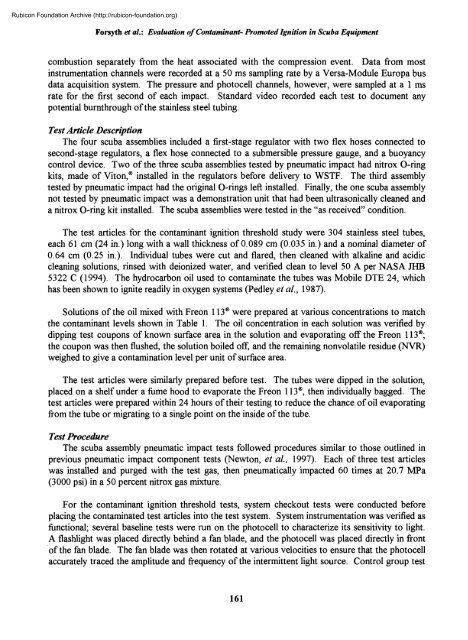Nitrox workshop dings - Divers Alert Network
Nitrox workshop dings - Divers Alert Network
Nitrox workshop dings - Divers Alert Network
You also want an ePaper? Increase the reach of your titles
YUMPU automatically turns print PDFs into web optimized ePapers that Google loves.
Rubicon Foundation Archive (http://rubicon-foundation.org)Forsyth et al.: Evaluation of Contaminant- Promoted Ignition in Scuba Equipmentcombustion separately from the heat associated with the compression event. Data from mostinstrumentation channels were recorded at a 50 ms sampling rate by a Versa-Module Europa busdata acquisition system. The pressure and photocell channels, however, were sampled at a 1 msrate for the first second of each impact. Standard video recorded each test to document anypotential burnthrough of the stainless steel tubing.Test Article DescriptionThe four scuba assemblies included a first-stage regulator with two flex hoses connected tosecond-stage regulators, a flex hose connected to a submersible pressure gauge, and a buoyancycontrol device. Two of the three scuba assemblies tested by pneumatic impact had nitrox O-ringkits, made of Viton,® installed in the regulators before delivery to WSTF. The third assemblytested by pneumatic impact had the original O-rings left installed. Finally, the one scuba assemblynot tested by pneumatic impact was a demonstration unit that had been ultrasonically cleaned anda nitrox O-ring kit installed. The scuba assemblies were tested in the "as received" condition.The test articles for the contaminant ignition threshold study were 304 stainless steel tubes,each 61 cm (24 in.) long with a wall thickness of 0.089 cm (0.035 in.) and a nominal diameter of0.64 cm (0.25 in.). Individual tubes were cut and flared, then cleaned with alkaline and acidiccleaning solutions, rinsed with deionized water, and verified clean to level 50 A per NASA JHB5322 C (1994). The hydrocarbon oil used to contaminate the tubes was Mobile DTE 24, whichhas been shown to ignite readily in oxygen systems (Pedley et al., 1987).Solutions of the oil mixed with Freon 113® were prepared at various concentrations to matchthe contaminant levels shown in Table 1. The oil concentration in each solution was verified bydipping test coupons of known surface area in the solution and evaporating off the Freon 113®;the coupon was then flushed, the solution boiled off, and the remaining nonvolatile residue (NVR)weighed to give a contamination level per unit of surface area.The test articles were similarly prepared before test. The tubes were dipped in the solution,placed on a shelf under a fume hood to evaporate the Freon 113®, then individually bagged. Thetest articles were prepared within 24 hours of their testing to reduce the chance of oil evaporatingfrom the tube or migrating to a single point on the inside of the tube.Test ProcedureThe scuba assembly pneumatic impact tests followed procedures similar to those outlined inprevious pneumatic impact component tests (Newton, et al, 1997). Each of three test articleswas installed and purged with the test gas, then pneumatically impacted 60 times at 20.7 MPa(3000 psi) in a 50 percent nitrox gas mixture.For the contaminant ignition threshold tests, system checkout tests were conducted beforeplacing the contaminated test articles into the test system. System instrumentation was verified asfunctional; several baseline tests were run on the photocell to characterize its sensitivity to light.A flashlight was placed directly behind a fan blade, and the photocell was placed directly in frontof the fan blade. The fan blade was then rotated at various velocities to ensure that the photocellaccurately traced the amplitude and frequency of the intermittent light source. Control group test161
















